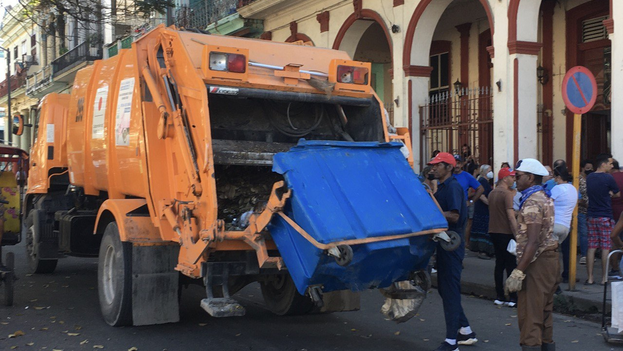
![]() 14ymedio, Natalia López Moya, Havana, 3 January 2022 — The rattle of the Community Services trucks has people climbing sidewalks to make way for the giant. Two men get out and push a garbage container cracked on its sides. Among flies and shouts, customers waiting to shop at the Plaza de Carlos III see the garbage bin rise, embraced by an improvised cloth band and drop the waste inside the truck. “Tremendous invention!” ironically exclaims one. “That is the creative resistance that [Cuban president] Díaz-Canel is talking about,” another mocks.
14ymedio, Natalia López Moya, Havana, 3 January 2022 — The rattle of the Community Services trucks has people climbing sidewalks to make way for the giant. Two men get out and push a garbage container cracked on its sides. Among flies and shouts, customers waiting to shop at the Plaza de Carlos III see the garbage bin rise, embraced by an improvised cloth band and drop the waste inside the truck. “Tremendous invention!” ironically exclaims one. “That is the creative resistance that [Cuban president] Díaz-Canel is talking about,” another mocks.
The trick is more desperate than artifice. “Many containers have lost their coupling and we had to get up to do something because otherwise it would be more work for us,” laments one of the workers from the State company who carries one of these bands in case he needs them. “Without this, part of the garbage would fall on top of us when we lift the container or we would have to use shovels to throw it into the truck. Nobody wants to work in these conditions, but it is what it is.”
For decades, Cuban authorities have boasted of the achievements of the National Association of Innovators and Rationalizers (ANIR), an entity that seeks to inventively solve the problems of supplying spare parts. But behind the praise, when an employee replaces an imported gear with one made on a domestic lathe or repairs complex foreign machinery with wire and old tubes, there is more desperation than ingenuity.
“First we had to invent a soyuz (coupler) to be able to use the garbage trucks donated by Japan with these containers because they were not compatible”
“First we had to invent a Soyuz (coupler) to be able to use the garbage trucks donated by Japan with these containers because they were not compatible,” Walfrido, a former garbage collection truck driver, explained to 14ymedio. Last April, the state worker was blunt when he defined the “little blue ones”: “They are not just bad, they are very bad.” After a few months, the original Soyuz was useless because, in most cases, the latching mechanism of the tanks broke.
When the azulitos (little blue ones) began to appear on Havana street corners a few years ago, they had that air of novelty that had many believing that the garbage problem in the Cuban capital was going to be solved. But the poor quality of these waste bins soon began to be noticed and was fatally combined with the looting that their less colorful cousins have always been subject to but have also ended up torn to pieces or disappeared in the streets of the Island.
“The pay is low, the salary is not enough for hardly anything and the working conditions are very difficult, but if the daily norm is not met then they are paid much less,” Walfrido details. “Now these bands have been devised, tomorrow we will have to use something else, and the day will come when the garbage will be collected all over Havana with a bulldozer if things continue like this,” he laments. While the “creativity” is provided by the Communal Services employees, the challenge falls onto the residents of the city, who will have to live with more mountains of waste.
____________
COLLABORATE WITH OUR WORK: The 14ymedio team is committed to practicing serious journalism that reflects Cuba’s reality in all its depth. Thank you for joining us on this long journey. We invite you to continue supporting us by becoming a member of 14ymedio now. Together we can continue transforming journalism in Cuba.
